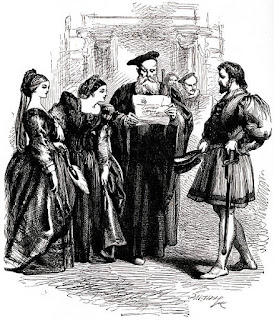To recap, walk-ons are a simple idea that can be a very effective tool. They can also easily get overdone or steer a scene in the wrong way.
Let's start by looking at examples in popular culture. I had a lot of trouble finding good clips because they are by their definition not hugely important, and usually they are not memorable. They are not meant to be memorable. You might remember the message they bring, but not the messenger. Which is mostly how it should be.
In movies, they are usually little more than a talking extra. The character that comes on and gives a report of what's going on is the classic. Or the character who adds to the terror by screaming "Oh, my god, it's huge. It'll destroy us all!"
In movies they don't actually have to walk on, because the camera can cut to them. But any character with who we see briefly and has one line, or only a few lines, is a walk-on.
A classic scenario for a movie is that an authority figure is approached by a second character, This second character gives a report of the current situation, is optionally given an order and leaves (or becomes once more a background figure). We'll take a look at a couple of a couple of examples. There might be spoilers, but mostly these are classic movies so if you haven't seen them yet, you haven't been trying.
There's a classic one in the original Star Wars movie, which is hard to find a good clip of, where an imperial officer enters and begins, "Lord Vader, the battle station plans are not aboard this ship! And no transmissions were made," and then pretty much leaves.
This is from the same movie and shows that it's not just humans that can do walk-ons, but also mouse droids. It's more comedic than explanational, but it is more than simply comic, it also highlights something of the characters we are following.
At the start of this next clip, from the classic nature-turns-on-man horror/thriller, The Birds, there is a walk-on which heightens the tension and unease of the main characters.
In Jaws, Harry, the old man on the beach character has a two-part walk-on. To first, heighten the tension and give us a false scare and then to give us some character exposition about the main character.
The final clip is a classic joke button at the end of a scene type walk-on (or in this case a CUT TO). In fact it's probably the most famous punchline end to scene by a walk-on character in the history of cinema: “I'll have what she's having.”
Some people might point out that the character is briefly shown earlier, but this is fine. Walk-on refers to the characters role in the current scene or moment, not their function in the whole piece. Here the character went from being background to being a walk-on.
Having an established character do a walk-on is perfectly fine, and happens a lot in movies and TV shows. The Simpsons is full of established characters who do walk-ons all the time. One of the clearest examples – and most used – is Herman Muntz and his iconic "Ha-ha!"
As they said in the movie Walk-On Club: “The first rule of Walk-On Club is you do not walk on unless it is absolutely necessary.” The second rule of Walk-On Club is once you've done the thing you were doing, walk the feck off stage.”
Other Resources
I got a lot of inspiration for the videos from The Greatest One Line Movie Roles from the Overthinking It channel.Here's a great set of succinct list of questions you could ask yourself before doing a walk-on from Jimmy Carrane.


